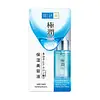What's inside
What's inside
 Key Ingredients
Key Ingredients

 Benefits
Benefits

 Concerns
Concerns

 Ingredients Side-by-side
Ingredients Side-by-side

Water
Skin ConditioningGlycerin
HumectantGlycereth-26
HumectantPropanediol
SolventButylene Glycol
Humectant1,2-Hexanediol
Skin ConditioningPanthenol
Skin ConditioningAlpha-Glucan Oligosaccharide
CleansingC12-14 Pareth-7
EmulsifyingTromethamine
BufferingAcrylates/C10-30 Alkyl Acrylate Crosspolymer
Emulsion StabilisingTrehalose
HumectantCarbomer
Emulsion StabilisingBetaine
HumectantXanthan Gum
EmulsifyingEthylhexylglycerin
Skin ConditioningDisodium EDTA
Hydrolyzed Hyaluronic Acid
HumectantHydroxypropyltrimonium Hyaluronate
Caprylic/Capric Triglyceride
MaskingPhosphatidylcholine
EmulsifyingHyaluronic Acid
HumectantCeramide NP
Skin ConditioningDisodium Phosphate
BufferingSodium Phosphate
BufferingSaccharide Isomerate
HumectantGlyceryl Caprylate
EmollientGlycine
BufferingMoringa Oleifera Seed Oil
EmollientSodium Hyaluronate
HumectantSerine
MaskingGlutamic Acid
HumectantLysine
Skin ConditioningAlgae Extract
EmollientAlanine
MaskingHydrolyzed Vegetable Protein
Skin ConditioningThreonine
Proline
Skin ConditioningArginine
MaskingCitrus Limon Fruit Extract
MaskingPhytosphingosine
Skin ConditioningHydrogenated Lecithin
EmulsifyingWater, Glycerin, Glycereth-26, Propanediol, Butylene Glycol, 1,2-Hexanediol, Panthenol, Alpha-Glucan Oligosaccharide, C12-14 Pareth-7, Tromethamine, Acrylates/C10-30 Alkyl Acrylate Crosspolymer, Trehalose, Carbomer, Betaine, Xanthan Gum, Ethylhexylglycerin, Disodium EDTA, Hydrolyzed Hyaluronic Acid, Hydroxypropyltrimonium Hyaluronate, Caprylic/Capric Triglyceride, Phosphatidylcholine, Hyaluronic Acid, Ceramide NP, Disodium Phosphate, Sodium Phosphate, Saccharide Isomerate, Glyceryl Caprylate, Glycine, Moringa Oleifera Seed Oil, Sodium Hyaluronate, Serine, Glutamic Acid, Lysine, Algae Extract, Alanine, Hydrolyzed Vegetable Protein, Threonine, Proline, Arginine, Citrus Limon Fruit Extract, Phytosphingosine, Hydrogenated Lecithin
Ingredients Explained
These ingredients are found in both products.
Ingredients higher up in an ingredient list are typically present in a larger amount.
Butylene Glycol (or BG) is used within cosmetic products for a few different reasons:
Overall, Butylene Glycol is a safe and well-rounded ingredient that works well with other ingredients.
Though this ingredient works well with most skin types, some people with sensitive skin may experience a reaction such as allergic rashes, closed comedones, or itchiness.
Learn more about Butylene GlycolThis ingredient is an emollient, solvent, and texture enhancer. It is considered a skin-softener by helping the skin prevent moisture loss.
It helps thicken a product's formula and makes it easier to spread by dissolving clumping compounds.
Caprylic Triglyceride is made by combining glycerin with coconut oil, forming a clear liquid.
While there is an assumption Caprylic Triglyceride can clog pores due to it being derived from coconut oil, there is no research supporting this.
Learn more about Caprylic/Capric TriglycerideDisodium EDTA plays a role in making products more stable by aiding other preservatives.
It is a chelating agent, meaning it neutralizes metal ions that may be found in a product.
Disodium EDTA is a salt of edetic acid and is found to be safe in cosmetic ingredients.
Learn more about Disodium EDTAGlycerin is already naturally found in your skin. It helps moisturize and protect your skin.
A study from 2016 found glycerin to be more effective as a humectant than AHAs and hyaluronic acid.
As a humectant, it helps the skin stay hydrated by pulling moisture to your skin. The low molecular weight of glycerin allows it to pull moisture into the deeper layers of your skin.
Hydrated skin improves your skin barrier; Your skin barrier helps protect against irritants and bacteria.
Glycerin has also been found to have antimicrobial and antiviral properties. Due to these properties, glycerin is often used in wound and burn treatments.
In cosmetics, glycerin is usually derived from plants such as soybean or palm. However, it can also be sourced from animals, such as tallow or animal fat.
This ingredient is organic, colorless, odorless, and non-toxic.
Glycerin is the name for this ingredient in American English. British English uses Glycerol/Glycerine.
Learn more about GlycerinSodium Hyaluronate is hyaluronic acid's salt form. It is commonly derived from the sodium salt of hyaluronic acid.
Like hyaluronic acid, it is great at holding water and acts as a humectant. This makes it a great skin hydrating ingredient.
Sodium Hyaluronate is naturally occurring in our bodies and is mostly found in eye fluid and joints.
These are some other common types of Hyaluronic Acid:
Learn more about Sodium HyaluronateWater. It's the most common cosmetic ingredient of all. You'll usually see it at the top of ingredient lists, meaning that it makes up the largest part of the product.
So why is it so popular? Water most often acts as a solvent - this means that it helps dissolve other ingredients into the formulation.
You'll also recognize water as that liquid we all need to stay alive. If you see this, drink a glass of water. Stay hydrated!
Learn more about Water